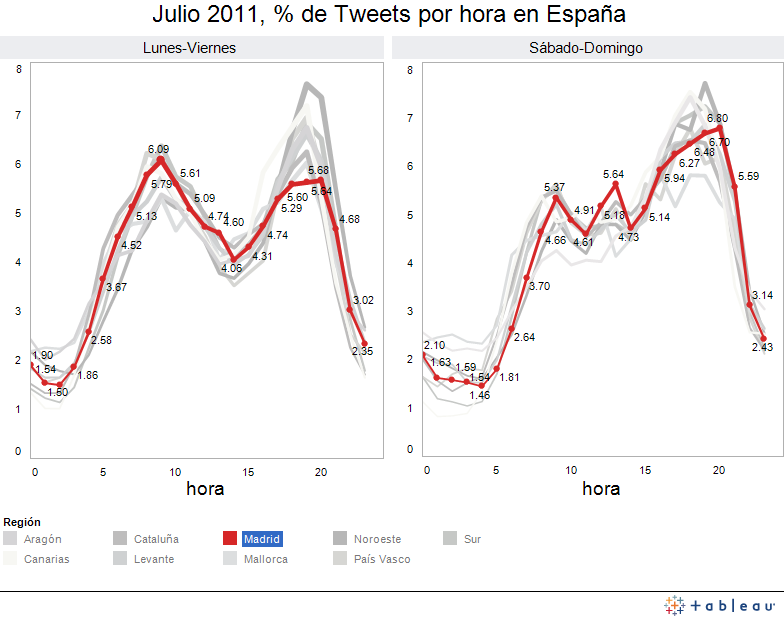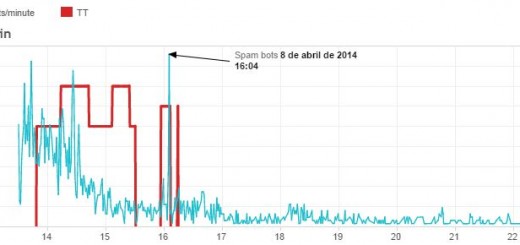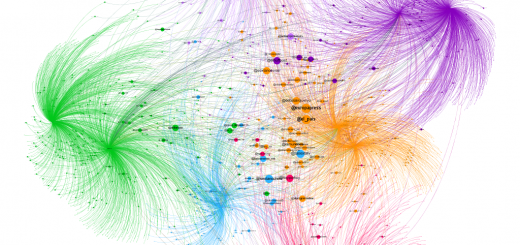No por mucho tuitear amanece más tempranoTwitter habits in Spanish regions
Actualizado 10-09-2011: Perdonar la confusión que puedo generar pero lamentablemente cometí un error en el ajuste de la hora GMT a la hora de España. En vez de sumar 2 en las regiones de la Península y Baleares y 1 en Las Islas Canarias, lo resté, de forma que los datos están adelantados 4 horas. Además, por un fallo del algoritmo los datos correspondían a la última semana de julio y no a la media de los datos del mes . Esto cambia mucho el análisis, encontrarán tachado en este post lo que no es cierto y pueden acceder aquí a la versión revisada. Cada vez más Twitter forma parte de la rutina de las personas, desde el ordenador, la tableta o el smartphone los usuarios siguen su TL y publican sus tweets. Gracias a la movilidad el lugar no es un handicap, tan solo el descanso o las tareas prioritarias son un freno para su uso. Por este motivo, analizando la actividad de sus usuarios se pueden deducir sus costumbres, permitiendo responder a preguntas como estas:
- ¿Qué patrón de publicación siguen las distintas regiones de España?
- ¿Se publica más por la mañana o por la tarde?
- ¿Qué regiones madrugan o trasnochan más?
- ¿Hay diferencia entre el Norte y el Sur o entre la Península y las Islas?
- ¿Cuál es el perfil de las regiones con grandes ciudades?
Todas estas preguntas tienen su respuesta en la siguiente gráfica que muestra el porcentaje de tweets publicados en cada hora durante el mes de julio en distintas regiones de España. En esta imagen estática aparece destacado Madrid pero pulsando en ella se puede acceder a la gráfica interactiva y seleccionar otras regiones o una combinación de ellas. En la gráfica aparecen de forma diferenciada los patrones de publicación de la semana laboral y del fin de semana

Esta imagen esta adenlantada 4 horas
Conclusiones:
- En los dominios de Twitter nunca se pone el sol. Siempre hay usuarios tuiteando a todas horas, no existe la noche para twitter.
- El mismo patrón de tráfico que el del Teléfono. Al ver la curva de tráfico de los tweets me vinieron a la memoria los tiempos en que trabajaba en conmuntación de circuitos porque se parece mucho al tráfico de llamadas telefónicas. Twitter no es más que otro canal para comunicarnos con los demás. Aunque tanto en la semana laboral como en el fin de semana los picos de publicación son a las 9:00 y a las 19:00, las curvas son algo diferentes. Durante la semana laboral toma forma de camello con dos jorobas pero en el fin de semana aparece una tercera joroba a las 11:00. Esta protuberancia puede deberse a los dormilones que se incorporan al TL y si esta hipótesis fuera cierta, los madrileños son a los que se le pegan más las sábanas.
- Mañanas vs. Tardes: Madrid marca una diferencia en la semana laboral porque tuitea más por las mañanas que por las tardes, pero en fin de semana sigue el mismo patrón que el resto de regiones. ¿será que en los días laborables de 18:00 a 20:00 están todos los madrileños en el atasco de tráfico? En la hora de la comida el País Vasco y el Noroeste son los que tienen más baja la frecuencia de publicación, cosa totalmente lógica dado que la tarea de comer no es nada trivial en el norte y requiere de toda su concentración. Por las tardes el Noroeste y Canarias son los que tienen una mayor actividad tuitera.
- Madrugadores vs. Trasnochadores la más madrugadora es Cataluña pero le siguen de cerca Madrid, País Vasco y Canarias. Los más trasnochadores son Aragón y Baleares.
- Norte vs. Sur: En cultura digital está todo por escribir. Se parece más el patrón de publicación del País Vasco al del Sur que al resto de las regiones del Norte.
- Islas vs. Península: las islas no pueden ser más diferentes, Canarias es madrugadora y Mallorca es trasnochadora. Canarias se parece al Sur y Mallorca no tiene parecido con ninguna otra región.
- Grandes ciudades: El volumen de tweets generado desde las grandes ciudades hace que las regiones a las que pertenecen queden condicionadas al patrón de las grandes urbes. Tanto Madrid como Cataluña muestran unos perfiles similares de publicación, ambas son madrugadoras y tienen menos actividad por la tarde que el resto de regiones..
Metodología:
- Datos recogidos de Twitter del 1 al 31 de Julio de 2011, 32.878.321 tweets de 1.660.275 usuarios únicos, con la siguiente distribución por regiones:
- Aragón: 1.003.958 tweets de 46.219 usuarios únicos
- Cataluña: 5.497.516 tweets de 284.585 usuarios únicos
- Canarias: 871.765 tweets de 37.105 usuarios únicos
- Levante: 3.016.412 tweets de 139.134 usuarios únicos
- Madrid: 9.045.342 tweets de 586.313 usuarios únicos
- Mallorca: 678.043 tweets de 41.318 usuarios únicos
- Noroeste: 5.137.426 tweets de 234.447 usuarios únicos
- País Vasco: 1.138.830 tweets de 59.578 usuarios únicos
- Sur: 6.489.029 tweets de 231.576 usuarios únicos
- Herramientas:
- herramienta de minería de datos propia
- Visualización con Tableau Public
Updated 10-09-2011 I’m sorry, unfortunately I made a mistake in setting the GMT time to Spain. Data are 4 hours early. This changes the analysis a lot and I will highlight the erroneous data in this post. Twitter is becoming more and more a part of people daily routine, from computers, tablets or smartphones, users follow their TL and publish tweets. Thanks to mobility, location is not a handicap, only to rest or to do priority tasks are an obstacle to using it. Therefore, analyzing the activity of their users we can understand their habits, allowing us to answer questions such as:
- What publication patterns are there in Spanish regions?
- When do people publish more in the morning or in the evening?
- What regions are early risers and which go to bed late?
- Is there a difference between the North and the South or between the mainland and the Islands?
- What is the pattern of the regions with large cities?
All these questions are answered in the following chart that shows the percentage of tweets posted every hour during the month of July in different regions of Spain. In this static image Madrid is highlighted but clicking on it you can access an interactive graphic and select other regions or a combination thereof. The graph shows a differentiated pattern of publication in the working week and at the weekend.
This image is 4 hours early
Conclusions:
- The sun never set on Twitter. Whenever users are tweeting all the time, night does not exist in Twitter world.
- Twitter has the same traffic pattern as phone calls. Seeing the tweet traffic curve it reminds me of the days when I worked with switching circuit because it resembles telephone call traffic. Twitter is just another channel to communicate with others. Although both, the working week and the weekend, peak publication is at 9:00 and at 19:00, the curves are somewhat different. During the working week it looks like a camel with two humps but at the weekend a third hump appears at 11:00. This lump may be due to the sleepers entering on the TL and if this hypothesis were true, people from Madrid are the sleepyheads in Spain.
- Morning vs. Evening: In the working week Madrid is different because there are more tweets in the morning than in the evening, but at the weekend it follows the same pattern as the other regions. Could it mean that in the working week from 18:00 to 20:00 all locals are in traffic jam? At lunchtime the Basque Country and the Northwest are those with the lowest frequency of publication, it could be logical because eating is not a trivial task in the north and it requires full concentration. In the evening the Northwest and the Canary Islands are those with most active tweeters.
- Early birds vs. Night owls.The earliest rise is Catalonia but is closely followed by Madrid, the Basque Country and the Canary Islands. The biggest revelers are Aragon and the Balearic Islands.
- North vs. South: In digital culture nothing is written. The Basque Country pattern is more similar to the South than other regions of the North.
- Islands vs. Peninsula: the islands can not be more different, the Canary Islands are early risers and the Balearic Islands are night owl. The Canary Islands are similar to the South and the Balearic Islands do not seem similar to any other region.
- Large cities: Regions with large cities are conditioned to the pattern of metropolis due to the volume of tweets generated.. Both, Madrid and Catalonia showed a similar profile, both are early risers and have less activity in the evening than other regions
Methodology:
- Data extracted from Twitter API since 1 to 31 of July of 2011, getting 32.878.322 tweets from 1.853.404 unique users, with this region distribution:
- Aragon: 1.003.958 tweets from 46.219 unique users
- Catalonia: 5.497.516 tweets from 284.585 unique users
- Madrid: 9.045.342 tweets from 586.313 unique users
- The Balearic Islands: 678.043 tweets from 41.318 unique users
- The Basque Country: 1.138.830 tweets from 59.578 unique users
- The Canary Islands: 871.765 tweets from 37.105 unique users
- The East: 3.016.412 tweets from139. unique users
- The Northwest: 5.137.426 tweets from 234.447 unique users
- The South: 6.489.029 tweets from 231.576 unique users
- Tools:
- Own datamining tools
- Visualization made with Tableau Public




Jaume, pues a mi lo que más me ha sorprendido son los aragoneses trasnochando. Respecto al Sur y País Vasco puede se vaya notando la emigración de vascos allí :-)
Muy interesante este post, realmente en la cultura digital esta todo por escribir.
Los mallorquines como siempre a lo suyo y el País Vasco y el Sur, se asemejan, quien lo diría.
Al final Twitter, como bien has dicho es un canal de comunicación más, por eso se asemejan tanto las curvas a las del teléfono.
Eso mismo pensé yo, que podía ser el pico de las 11 de hacer planes, pero como soy pesimista me decanté por la pereza :-)
Será mitad y mitad
Sobre la joroba de las 11:00 el fin de semana, es cierto que bien pueden ser los «dormilones».
Se me ocurre, sin embargo, que también recoja esa joroba el momento en el que hacemos planes o nos ponemos en marcha — «hoy, playa», «hoy, visita a tal sitio», etc. — y que es una situación que no suele darse entre semana, donde le plan está más que prefijado.